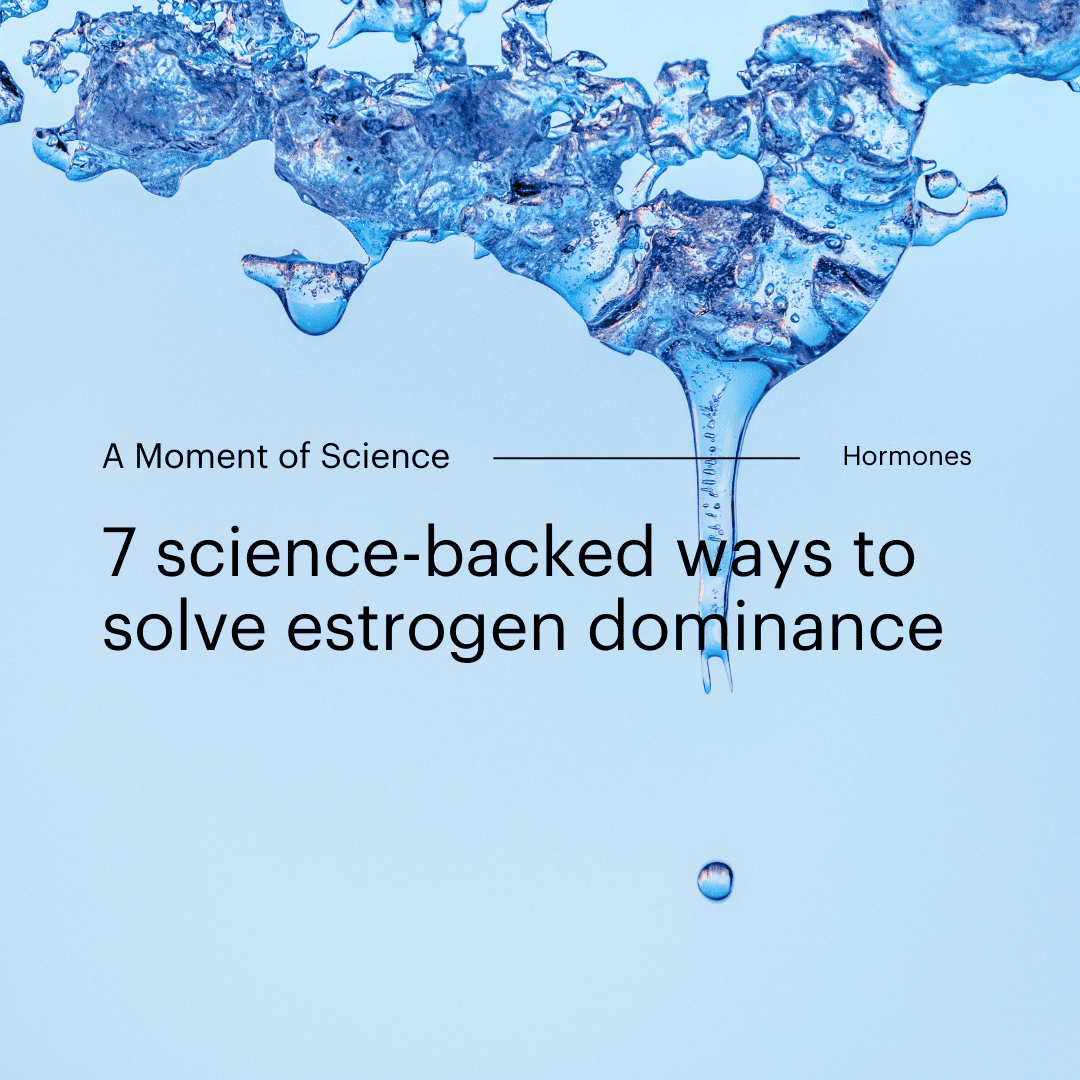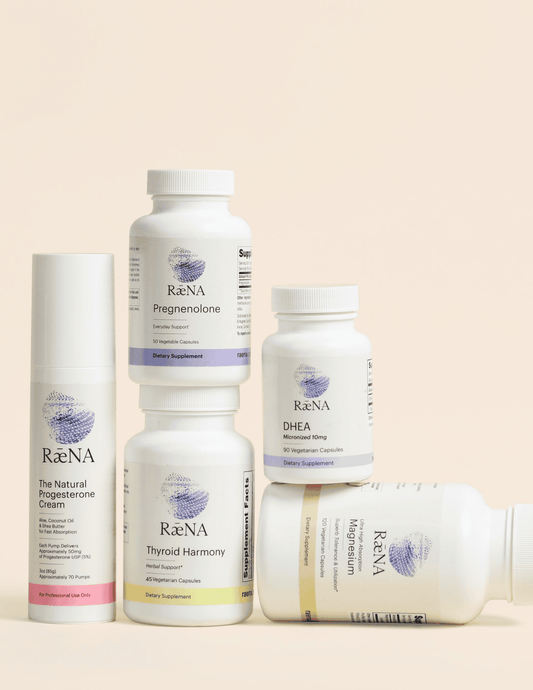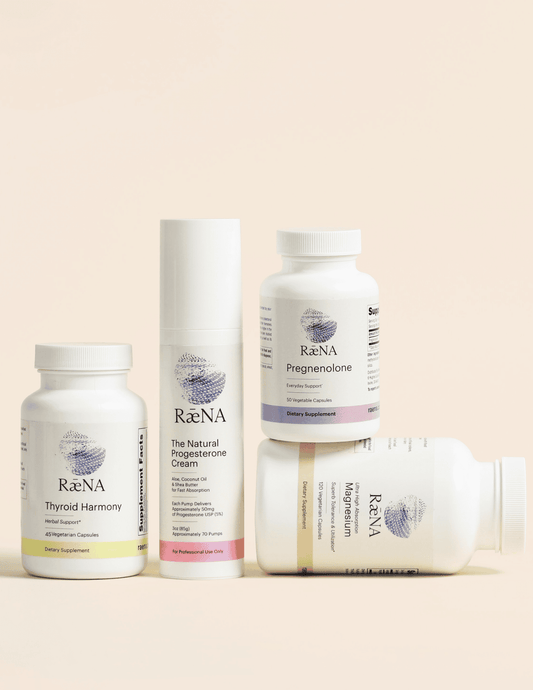
7 Science-backed ways to solve estrogen dominance
Raena
Estrogen dominance is a condition of a person having deficient, normal, or excessive estrogen but little or no progesterone to balance its effects in the body. Estrogen is crucial for day-to-day functioning. It regulates menstruation, hunger, satiety, insulin sensitivity, helps you metabolize cholesterol, contributes to bone density, and more. However, sustained monthly estrogen dominance leads to a wide variety of medical problems stemming from unopposed estrogen side effects.
The symptoms of sustained monthly estrogen dominance can lead to a wide variety of medical problems. Some women experience:
Headaches or migraines
PMS
Heavy periods
Irregular cycles
Breast tenderness
Night sweats or hot flashes
Poor sleep
PCOS
Fatigue
Fibroids, cysts, and other kinds of growths
Endometriosis
Fibrocystic breasts
Endometrial cancer and breast cancer
Estrogen dominance in this day and age is increasingly common. The main causes of estrogen dominance include obesity, malnutrition, certain medications, sluggish liver function, and the environment.
Estrogen dominance is often determined by the Pg/E2(progesterone to estrogen) ratio.
When progesterone is low in relation to estrogen, then the ratio goes lower. This ratio helps doctors determine if estrogen dominance is present in a woman. This also suggests relative progesterone deficiency.
If your progesterone levels decrease at a faster rate, you can still become estrogen dominant, no matter how little estrogen you actually have in your system. So long as you have lower levels of progesterone than estrogen, you are likely to experience many of the symptoms associated with estrogen dominance.
- Maintain a healthy body weight
More fat cells come with more estrogen because fat cells make and store estrogen.
Fat cells also promote cortisol which can convert 2-Hydroxyestrone into 16-Hydroxyestrone, promoting an even higher estrogenic state, which in turn encourages more cortisol, which in turn promotes more estrogen. This results in sustained monthly estrogen dominance leading to a wide variety of medical problems stemming from unopposed estrogen side effects.
When consuming the Standard American Diet, one tends to carry more fat on the body. Diets high in processed foods, hallmarks of the standard American diet, are often to blame. Moving the body and eating a nutrient-dense diet is key!
2. Vitamin E
Vitamin E is a fat-soluble vitamin with several forms, with alpha-tocopherol being the most biologically active form. This fat-soluble nutrient plays an important role in vision, reproduction, brain health, and skin health. It is also an antioxidant that stops the production of reactive oxygen species formed when fat undergoes oxidation.
Several studies have shown that vitamin E’s therapeutic benefits in relation to healthy estrogen levels.
One study investigated vitamin E’s impact on breast cancer. "…In conclusion, our study is one of the first to report the effect of vitamin E on estrogen response of breast cancer cells. It provides evidence that vitamin E (α-tocopherol) may be a new nonsteroidal environmental anti-estrogen, and dietary supplementation of vitamin E may be a preventive measure for breast cancer."
What does this mean for hormones? Vitamin E can act as an estrogen antagonist just like progesterone. This effect has important significance in regards to treating estrogen dominance, a state in which the body has too much estrogen.
3. Avoid exposure to xenoestrogens
Estrogen dominance may also be linked to exposure to xenoestrogens (toxic compounds that mimic estrogen and wreak havoc on your endocrine system) and inadequate estrogen clearance due to sluggish liver function. If your liver is overworked dealing with other toxins, estrogen does not get properly metabolized and may then be recirculated back into your system. The resulting high estrogen levels may cause inflammation in the body.
Examples of xenoestrogens include phthalates (used in plastics and cosmetics), pesticides, tobacco smoke by-products, and various solvents. Xenoestrogens enhance the effects of estrogen in the body by binding to estrogen receptors. They can also reduce the concentration of progesterone and one study showed, " …Di-n-octyl phthalate (DnOP) and diisononyl phthalate (DiNP) metabolites were associated with reduced progesterone concentrations" (Jacobson et al., 2021).
It's key to avoid and reduce exposure to xenoestrogens!
4. Natural progesterone
When there is excess estrogen in the body, there is almost always a progesterone deficiency. Balancing your estrogen and progesterone levels by using bioidentical progesterone cream may help.
Natural progesterone can help to reestablish a balance of hormones. Many patients benefit from starting with a physiological dose to minimize high estrogen levels in the body.
If a woman still has her menstrual cycle, the normal pattern of progesterone secretion during the month is for the ovaries to produce a large amount in the 2nd two weeks of the menstrual cycle, (i.e., day 14 through day 28) beginning at ovulation and ending around the beginning of menstruation, and then to produce little for the following two weeks. If a woman does not have her menstrual cycle, progesterone is often taken every single night or morning because it can have a protective effect
5. Vitamin B1, B2, B3
A deficiency in B vitamins can make it impossible for your liver to excrete estrogen, leading to a chronically high estrogen level. B vitamin deficiencies can also play a role in everything from aging, neurological disorders, and mental illness, to cancer, cardiovascular disease, and infertility Thiamine (B1), riboflavin (B2), and niacinamide (B3) are essential for the liver to be able to properly inactivate estrogen and excrete it. B vitamins to support detox pathways may be helpful.
One recent study reported, "The level of ERα (Estrogen receptor) mRNA in MCF-7 cells was also reduced after treatment with SN (100 μM) and nicotinamide (20 mM) (Figure 1B)" (Yao Y et al., Carcinogenesis).
Several food sources are high in B vitamins such as
liver, potatoes, seafood, and eggs.
6. Healthy thyroid function
Healthy thyroid function is key to normal estrogen levels because excess estrogen levels or “estrogen dominance” causes the liver to produce high levels of thyroid-binding globulin (TBG), which, as its name suggests, binds the thyroid hormone and decreases the amount of thyroid hormone that can be utilized by the cells.
Many women with thyroid problems have high estrogen levels. Estrogen promotes cortisol and vice versa, the problem feeds on itself. Hypothyroidism can prevent the liver from detoxifying estrogen. Improving liver health seems to be a valuable asset to lowering estrogen levels.
A thyroid supplement can reliably lower estrogen, by increasing the liver's ability to excrete it. Selenium can also help activate thyroid function.
7. Vitamin A
Vitamin A lowers estrogen by inhibiting aromatase (the enzyme that converts androgens into estrogens). Vitamin A protects some tissues, such as the breasts, against estrogen's effects, including cancer, and generally offers protection against estrogen by increasing progesterone.
One study showed, "This is the first report on the antiestrogenic activity of ATRA (the primary active metabolite of vitamin A) determined using an in vivo adult rat uterotrophic assay. The up-regulation of RAR or RXR mRNA expression level was probably responsible for the antiestrogenic activity of ATRA."
DISCLAIMER
This content is strictly the opinion of Raena and is for informational and educational purposes only. It is not intended to provide medical advice or to take the place of medical advice or treatment from a personal physician. All viewers of this content are advised to consult their doctors or qualified health professionals regarding specific health questions. Neither Raena nor the publisher of this content takes responsibility for possible health consequences of any person or persons reading or following the information in this educational content. All viewers of this content, especially those taking prescription or over-the-counter medications, should consult their physicians before beginning any nutrition, supplement or lifestyle program.

